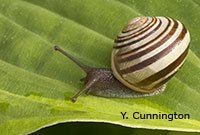Hosta lovers hate to find slugs and snails feeding on their plants.
Hostas grow in a rich, woodsy soil, but these moisture-loving pests enjoy the same conditions and chew holes in the leaves, which can leave a hosta plant looking tattered. These garden pests also feed on the foliage of other flowering plants, including delphiniums and dahlias.
Snail and slug habits

Snails chew hosta leaves
These pests are most active at night and on cloudy or foggy days. On sunny days they hide in spots out of the heat and light.
Their damage can be particularly noticeable during seasons in which there’s more rain than normal.
When choosing hostas,
go for resistance
Choose resistant hosta cultivars. Hostas described on nursery tags as slug proof, resistant, or as having “good substance” – thick, dense leaves with a good waxy coating are a good bet. As luck would have it, these tend to be the most desirable and attractive cultivars.
Blue leafed hostas tend to be resistant. Try H. sieboldiana ‘Elegans’, ‘Krossa Regal’, ‘Love Pat’, ‘Blue Moon’, ‘Blue Angel’, ‘Blue Umbrellas’ and ‘Halcyon’. In the gold varieties, try ‘Gold Edger’ and ‘Sum and Substance’; in the green ones, look for ‘Invincible’ and Hosta tardiflora, and in the variegated hostas, try ‘Reversed’ and ‘Shade Fanfare’ or ‘Grand Master’.
Effective slug control measures
You’ll get the best control of these pests with a combination of the methods listed here:
Set traps where the pests hide during the day. Boards, stones or orange peels can be used. Then check the traps regularly and remove pests hiding there.
Beer set into the ground in a container will attract and drown these pests. Use a container about 4 or 5 inches deep, dug into the ground so that the top is even with the surface of the soil. Fill with beer to within an inch of the top so slugs have to extend to reach it, which causes them to fall in and drown.
Diatomaceous earth is effective. This natural substance consists of fossilized skeletons of marine and fresh water organisms crushed into a powder of tiny glass-like pieces. When these slimey pests get it on their bodies, they lose water rapidly, and dry up and die. It also repels them because they try to avoid contact. This must be reapplied after every rainfall.
Commercial baits are available. The older types had to be used with extreme caution as they contained metaldehyde, which ia dangerous to birds, pets and even small children. There are now safer controls using iron phosphate, sold under names such as Sluggo and Safer’s Slug Bait, that will not harm birds, pets or wildlife and are safe for the environment.
Put the bait in place (following package instructions as to the amount to use) early in the season when the foliage is just starting to emerge. Set it in moist dark areas where the pests like to hide.
Avoid watering your garden in the late afternoon or evening, so your plants and the ground have a chance to dry out before dark. Switching from watering by sprinkler to drip irrigation or soaker hoses can reduce humidity and moist surfaces, making your garden less attractive to these pests.
Diluted ammonia before hostas leaf out is a homemade control that many hosta lovers swear by. Fill a spray bottle with one part ammonia to nine parts water, and spray the plants and the soil around them (where eggs have been laid). Do this very early in spring just before the hostas begin to leaf out, and don’t use when leaves are growing, as it could potentially damage them.
Some gardeners swear by copper strips. Dagmar Lynch of North Vancouver wrote in to say: “The garden centres are selling copper strips to place around plants. It ‘electrocutes’ the pests as they try to climb over the copper to get to your plants. Just place the copper around each plant, making sure there is no ‘bridge’ (leaf, soil, etc.) for the crawling pests to cross. I tried it last year around my dahlias and it really works!”
Related Information
More on controlling garden pests
Hostas: favorite shade perennials




